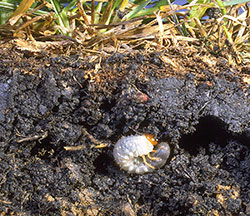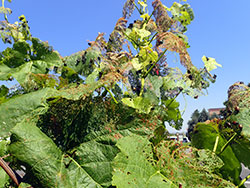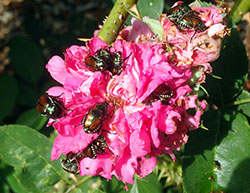
What are Japanese Beetles?

The adult Japanese beetle has an oval form is about 7/16-inch in length. It is generally metallic green with copperybrown wing covers, which do not quite cover the tip of the abdomen. Along the sides are five patches of whitish hairs. The antennae are clubbed at the end and may spread to a fan-like form.
Japanese beetle larvae are a type of white grub that feeds on the roots of grasses. They have a creamy white body with a dark head and the legs on the thorax are well developed.
Japanese Beetles in Colorado:

“For close to a century, the Japanese beetle (Popillia japonica) has been one of the most seriously damaging insect pests of both turfgrass and landscape plants over a broad area of the eastern US. Recently, there have become a few permanent, reproducing populations of this insect in some communities along the Front Range of Colorado. At some of these sites high numbers of Japanese beetles now regularly occur and adult beetles are causing significant damage to leaves and flowers of many susceptible landscape plants.”
—Dr. Whitney Cranshaw
Here in Denver, Japanese beetle is the new reality. We are going to have to deal with this insect pest and unfortunately, it is established to such a degree that eradication is not possible.
Some important highlights from the Japanese beetle CSU Extension factsheet by Dr. Cranshaw include:
Beware: Do not use the trap!
“Repeated trials have demonstrated that use of such traps does not reduce the number of beetles damaging nearby vegetation. Furthermore, the use of Japanese beetle traps often increases damage by Japanese beetles by drawing into the vicinity larger numbers of beetles than are captured in the traps. Because of this Japanese beetle traps are not recommended for Japanese beetle control.”
When Hand Picking is the Best Option:
“Hand picking beetles can sometimes be effectively employed in small plantings. The beetles are easily picked or dislodged; shaking infested plants over a collecting container in early morning when temperatures are cool can be particularly productive. The regular removal of beetles prevents the feeding damage produced by the beetles, which can reduce the production of chemicals produced by wounded plants that are attractive to the adult beetles.”
Use Insecticides Responsibly:
If Japanese beetles are damaging flowering plants, this last feature, the potential for hazard to pollinators, is very important in determining what kinds of insecticides can be used.
Insecticides that are highly toxic to bees and can persist long enough to kill insects for days are hazardous to pollinating insects that visit the flowers. These include products with the active ingredients carbaryl, bifenthrin, beta-cyfluthrin, lambda-cyhalothrin, permethrin, and imidacloprid. These insecticides normally have label instructions to prohibit their use when there are flowers in bloom that are attractive to bees.
The CSU factsheet has many more useful facts and strategies for dealing with this distressing pest. If you have questions or concerns about Japanese beetle, please don’t hesitate to reach out.
Fact Sheet
Announcement
Colorado State University Denver Extension staff are currently working a hybrid schedule with in-office presence depending on the day of the week. Please call or email before you visit to make sure that a staff member will be available to help you.





